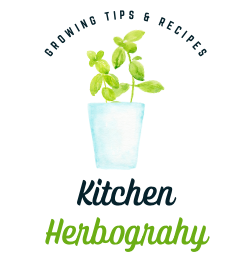As an Amazon Associate I earn from qualifying purchases. This website also participates in other affiliate programs and may earn commissions if you shop through the links used on this website.
(This article was originally published on August 6, 2021 and was last updated on September 15, 2022)
Dry soil is the most common reason for a basil plant wilting. If your basil plant is drooping or wilting, check the soil and reconsider your watering schedule. If you can’t solve it with a simple change in watering, keep reading for the most common reasons for wilted basil.
Basil is one of the most popular types of plants for culinary gardeners to grow. And while it’s generally pretty easy, it can be somewhat finicky to care for. If you find yourself faced with wilting basil, this article provides some help. Keep reading for my top strategies to revive a wilted basil plant.

Why is my Basil Plant Wilting? The Most Common Explanation
Soil that’s too dry or too wet is the most common reason for a basil plant wilting. Although basil plants thrive in full sunlight, they also need consistently moist, high quality soil with good drainage. If your basil plant is drooping or wilting, check the soil and reconsider your basil watering schedule.
This picture below shows an overwatered basil plant, which has noticeably yellowing leaves, and is droopy due to the over watering.
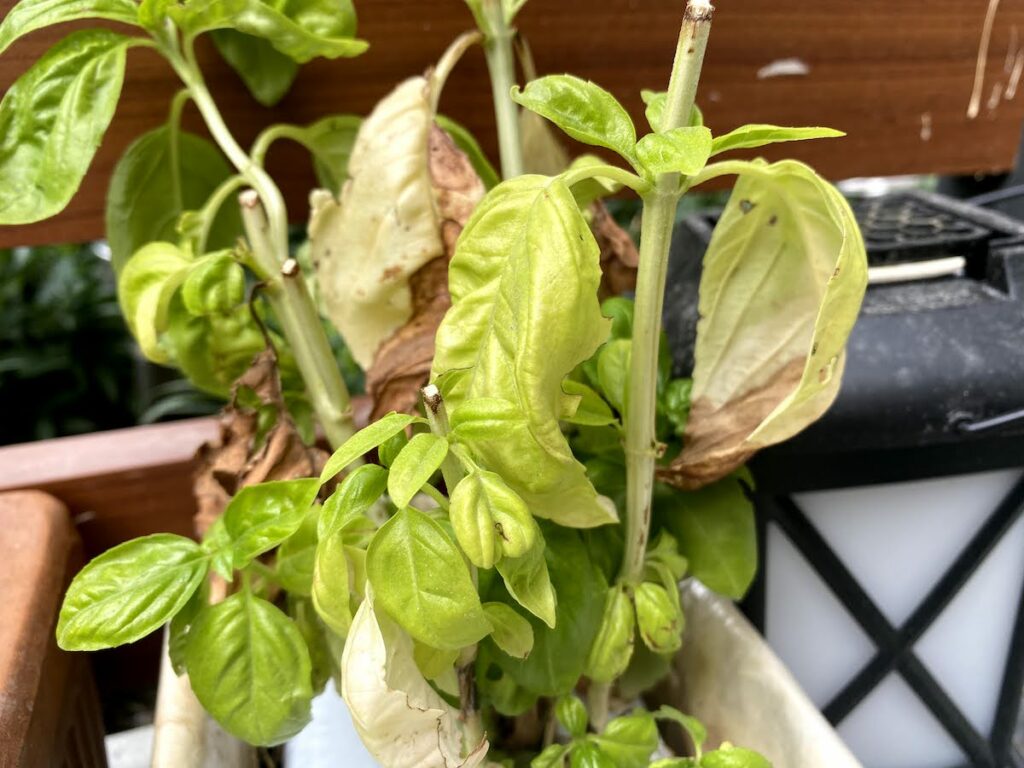
More Than 7,000 People Can’t Be Wrong!
For one-off problems (like wilting or drooping!) with your basil or herb garden, a quick Google to solve the problem is great.
But if you want more help getting the herb garden of your dreams, mastering cooking with basil, or other creative uses of basil, Skillshare has some awesome herb-related courses (plus a ton of other interesting, useful and cool courses).
To date, more than 7,000 students have taken Indoor Gardening: Grow Houseplants, Veggies, and Herbs!
Normally Skillshare Gives A 7-Day Free Trial. You Get A 30-Day Free Trial (OR 30% Off An Annual Membership)
Our friends at Skillshare have graciously offered our readers an extended free trial, using this link here to sign up. Instead of 1 week to try out all their courses, you get a full month to try courses like:
- Indoor Gardening: Grow Houseplants, Veggies, and Herbs // (use this link to get a 30-day Free trial) // (use this link to 30% off an Annual Membership)
- Create a Small Space Edible Garden // (use this link to get a 30-day Free trial) // (use this link to 30% off an Annual Membership)
- 5 Easy to grow herbs, sowing, growing and harvesting // (use this link to get a 30-day Free trial) // (use this link to 30% off an Annual Membership)
- Crafting Infused Tea: Herb, Flower, and Fruit Iced Teas // (use this link to get a 30-day Free trial) // (use this link to 30% off an Annual Membership)
Sign up for a FREE 30-Day Trial (this link only)
Or Save 30% Off An Annual Skillshare Membership
If you know you’re going to love Skillshare, you can also sign up for an annual membership and save 30% with this link.
Wilted Basil and Its Discontents
Basil thrives in high quality, moist soil, and is fairly sensitive to changes in growing conditions.
If you have a basil plant drooping in its pot or garden, here are some of the conditions you can control that could cause basil to droop or wilt:
- Not adjusting your watering frequency in response to a change in weather or climate conditions. If you’re experiencing a heat wave, or have simply changed from spring to summer weather conditions without watering your basil plant more frequently, it could be that the plant doesn’t have enough consistent moisture.
- Inadequate drainage. Basil loves moist soil, but it doesn’t tolerate being over watered. Soupy or boggy soil conditions can be just as damaging to a basil plant as dry soil, which is why you need to ensure your pots and soil has adequate drainage, and the basil’s roots doesn’t sit in standing water.
- Poor choice of planter or plant pot. Basil loves both full sun and cool, moist soil, which means you need to consider the planter material carefully. Most established basil plants in the garden center or supermarket are sold in thin plastic pots. Unfortunately, those plastic pots are excellent at conducting heat, causing the soil to heat up and dry out faster than more natural materials, such as terracotta, clay or ceramic.
- Infrequent pruning. Basil needs to be cut back and pruned once every two weeks or so, or once it reaches 8 inches in height. If you don’t prune regularly, it can start wilting or look droopy. By pruning the top of the plant, you get to use the leaves, but you also allow the leaves that sit lower on the plant better access to sunlight.
- A dramatic change in growing conditions, such as would occur with a heat wave or cold snap, or if you transplant the plant from the supermarket, or a basil seedling you’ve grown yourself from indoors to your home garden, or a cutting you’ve grown in water into soil, or move a basil plant indoors after being in an outdoor garden, can shock your plant. If this is the case, it will require a bit of time and care to get your plant back to its best self.
Basil can also wilt or droop towards the end of its growing season. It’s annual plant, and once its flowered, it may drop or wilt.
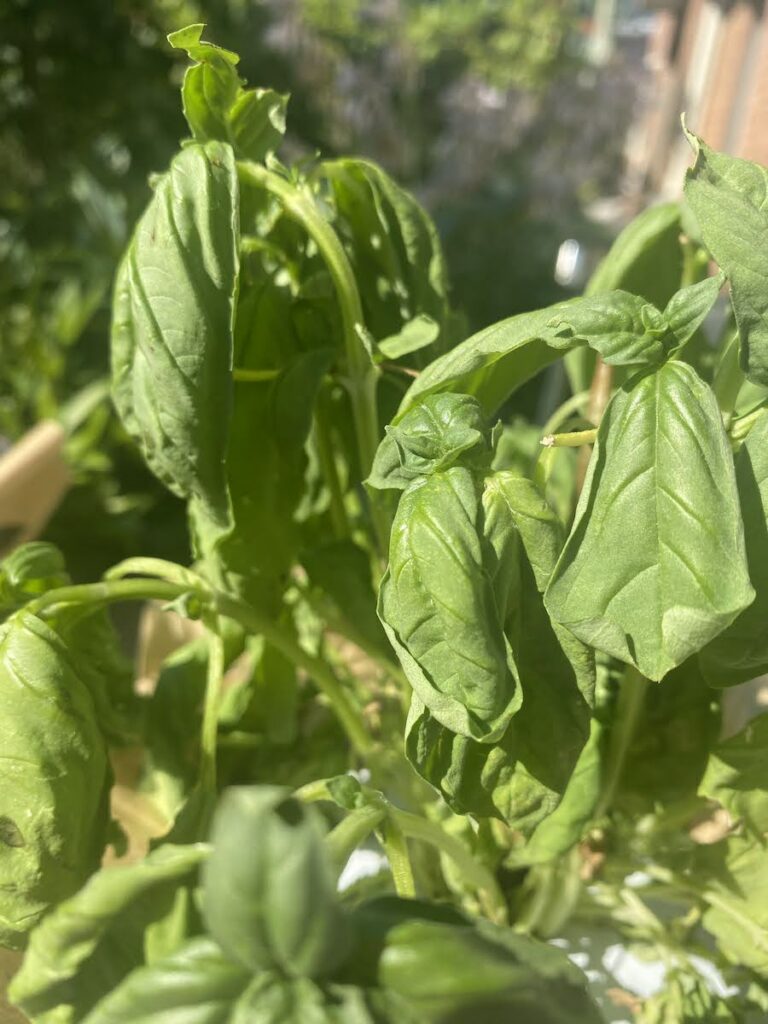
The Most Common Causes of Wilted Basil – And What to Do About it
The Soil is too Dry / Under Watering
When an established basil plant doesn’t have enough moisture in the soil, it will wilt fairly quickly as the large leaves transpire the moisture.
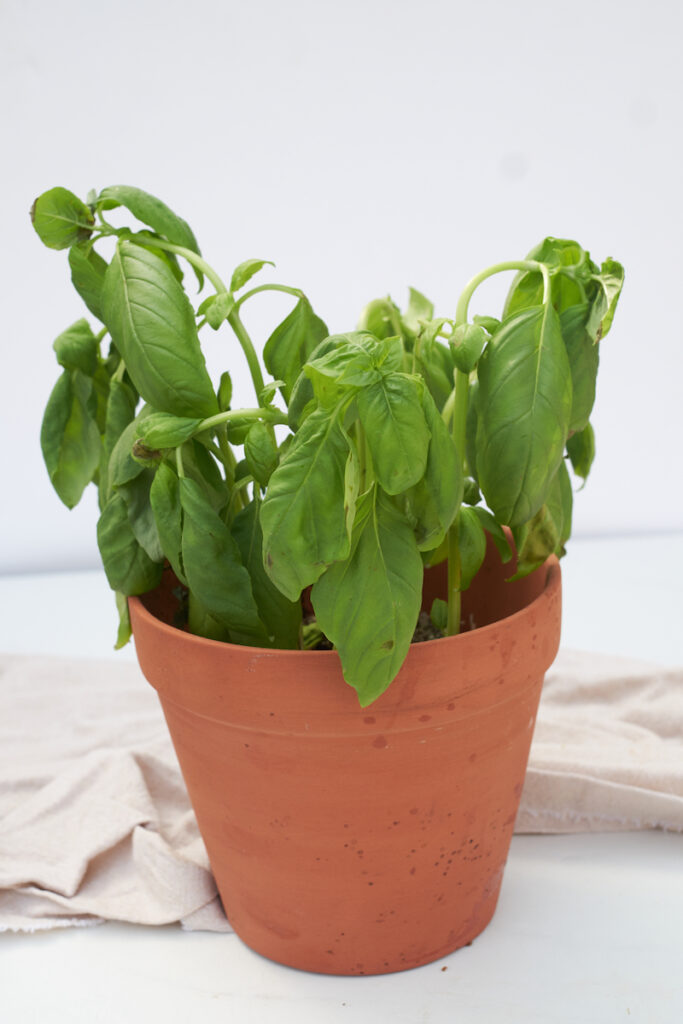
Many novice gardeners find basil tricky, because it demands full sun AND consistently moist soil.
That’s a tough balance to strike!
The best way to achieve optimal moisture conditions is to use plenty of organic materials (compost, leafmold, etc) to prep the soil before you plant, water frequently, and monitor the soil on the days between watering.
If your basil plant doesn’t have enough moisture in the soil, it will wilt fairly quickly. The good news is, basil plants that wilt due to a lack of water can generally recover within 2 or 3 days of care.
- Visually inspect your basil plant. If the soil has pulled away from the edge of the pot, it’s too dry. Also stick your finger down into the soil and notice it feels dry, give your basil plant a good soak right away. If you’re watering a potted basil plant, soak it near the base of the plant / surface of the soil until the pot starts to leak water out near the bottom. If you’re watering basil that’s planted in your garden, water until the soil is moist to around 1 inch below the surface.
- If your potted basil plant is wilting, after watering take care to give the plant some shade over the next few days while it recovers, particularly during the hottest point of the day and if you’re experiencing unusually hot temperatures. Once the plant has recovered, move it back into full sun.
- Consider mulching the surface of the soil to conserve moisture and reduce evaporation.
- Increase the frequency of watering if needed. In hot weather, you may need to water daily or every second day, particularly if it’s in a small pot. You should also water in the morning, before the heat of the day sets in.
The Soil is too Moist / Over Watering or Poor Drainage
Just as under watering can cause wilted basil, so can over watering.
While basil grows best in moist soil, it doesn’t tolerate over watering. Soil that’s too wet, and is soupy or boggy, tends to damage the plant roots and cause root rot. Leaves that are turning yellow is another sign this is the problem.
Establishing adequate drainage is a critical part of growing healthy basil plants that don’t wilt.
If you have wilted basil that isn’t caused by dry soil, consider whether the soil is too moist or lacks adequate drainage:
- Basil planted in your garden can suffer from inadequate drainage if you have slow draining soil, such as clay. If you can’t get adequate drainage in your garden, or can’t let the soil dry out due to soil type, consider transplanting your basil to a pot.
- Plants in plant pots can suffer if the pots lack drainage holes in the base, for excess water to flow out of the pot. If you have soggy soil and are concerned this is the cause, either add more holes for drainage (if possible) or re-pot. Watch to see if the soil dries, which should let you know you’ve solved the problem.
- Likewise, potted basil shouldn’t make use of a drip tray under the pot, as this causes the water to pool, rather than drain away. Remove the drip tray if you’ve been using one to see if it helps to resolve the issue. If you’re growing your basil plants inside, move them to the kitchen sink when watering to avoid them dripping all over the place, but don’t skimp on adequate drainage.
If you’re concerned the soil is too moist, adjust your watering frequency or transplant the plant from garden to pot, or from a pot with poor drainage to one with better drainage.
When choosing an ideal plant pot for basil, choose something large (12″ wide across or more), made from natural clay, terracotta or ceramic, and with plenty of drainage holes so excess water can drain away.
These pot recommendations hold for growing basil inside, too. Don’t use a drip tray! Instead, you can move your pot to the kitchen sink or outdoors to water, and let the water drain away into the sink or ground, and then place a few layers of paper towel or a tea towel under the pot before returning it to its normal spot.
Soil is Drying Out Too Quickly Due to Pot Choice
Basil plants often wilt because they are planted in a pot that’s too small, made from plastic, and with not enough soil.
When you buy established basil plants from the garden center or supermarket, they tend to come in small, thin plastic plant pots.
While those small plastic pots are a cheap solution for the garden center, they’re not suitable for growing a healthy basil plant over the long term.
For one, they’re too small. Small pots have limited capacity for soil, which means in turn they have limited capacity for moisture. The limited volume of soil that is there soaks up water quickly, but it also dries out quickly. The soil in small pots can’t maintain consistent moisture over a period of several days to a week, and in turn the basil struggles to thrive.
Additionally, plastic isn’t a good material for a basil pot. It conducts heat well, and as basil thrives in full sun, the plastic pots soak up the heat from the sun, contributing to both heating and drying of the soil.
Use a larger pot, made from a natural material that stays cooler in the sun, such as terracotta, ceramic, clay, or stone. In terms of size, 12 inches in diameter or larger is a good size, and at least 4″ deep.
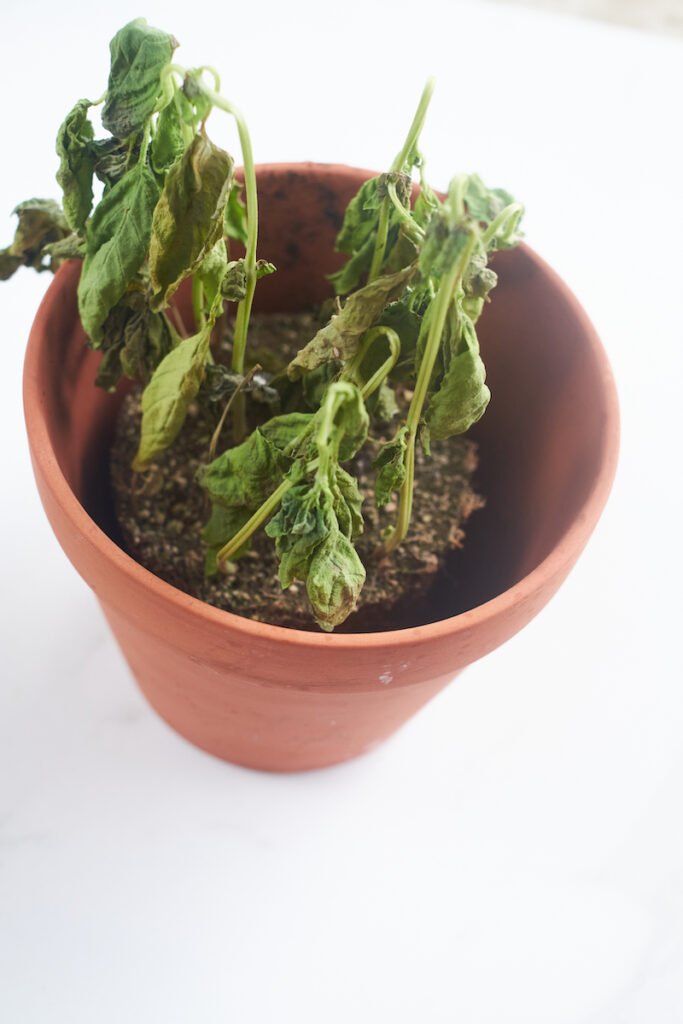
If you have a smaller pot, or a plastic pot, you can still grow a healthy plant, but will need to monitor soil moisture more closely and frequently.
Growing Cycle, Pruning and Flowering
Allowing your basil plant to flower is another common reason for wilted basil.
In most of North America, Basil grows as a short-lived annual plant, unable to withstand light frost.
Left on its own, it will flower and produce seeds, at which point it is much less productive in terms of producing new leaves for you to enjoy.
If it goes through flowering and seeding, you’ll likely notice the leaves wilt after flowering, and the remaining leaves aren’t as good for culinary use.
To prevent a basil plant from flowering, you need to stay on top of pruning and harvesting your plant. Prune from the top of the plant. You can use the leaves you pull off the plant for recipes, and pulling leaves from the top will let those lower down on the plant to get more sunlight.
This process encourages more leaf growth, and a plant that is productive for longer than one left to its own natural growing cycle.
If you don’t prune, your basil plant will flower, go to seed, and wilt. Regardless of whether you prune or not, most basil will only last less than a year. However, by undertaking regular pruning, you can extend its productive life. Once it does go to seed, you can keep the seeds to grow seedlings next year.
Note, once your basil does flower, you’ll notice the flowers have a lovely sweet aroma, and they’ll attract bees to your garden! You can enjoy the flowers in a vase, or you can add them to recipes, as basil flowers are edible!
Changes in Growing Conditions
Basil is fairly sensitive to growing conditions, preferring full sun, and consistent temperatures and moisture conditions.
When those conditions change, due to a change in weather or season, you might find your basil plant dropping soon after.
Basil Plant Wilting Due to a Sudden Cold Snap
A cold snap can cause wilted basil, even if the temperature change doesn’t result in a frost (which would likely kill the basil plant). When a basil plant is exhibiting signs of stress related to cold weather, you’ll notice wilting, curling leaves, and brown edges on the leaves. Prune these, and take extra care of the plant over the following days, moving it inside if needed while it recovers.
Wilted Basil Due to Higher Than Normal Temperatures or a Heat Wave
Although Basil can tolerate high temperatures as long as you keep the soil consistently and adequately moist, higher than usual temperatures can cause your basil to wilt. For example, I noticed my basil plants were under stress after the last heat wave we experienced in the PNW!
Support the plant by increasing watering due to times of heat-induced stress, giving it a good soak and checking moisture levels to ensure it’s moist but not soupy soil. If you haven’t already, this is also a good time to add some mulch to the surface of the soil which will help retain moisture and keep evaporation at bay.
Wilted Basil After Transplanting the Plant
If you find yourself with a basil plant wilting shortly after you’ve brought it home from the garden centre and re-potted it, it may be because of transplant shock.
Transplant shock is a common reason for wilted basil, and it’s mostly due to the sudden change in growing conditions.
If you bought your plant indoors (i.e. it was used to greenhouse or indoor conditions at the garden centre or supermarket) and planted it outdoors, consider bringing it inside for a few days to recover, and then placing it outside daily in full sun once the day has warmed up, or in a sunny window. You should notice a slight recovery within a few days, and a full recovery within a week or two.
Likewise, if your plant is used to being outside, and you bring it inside, it might also wilt due to a temperature change. Reasons you may want to bring your plant inside include recovering from a pest infestation that’s causing holes in the leaves or a bacterial or fungal infection that’s causing brown spots, causing the leaf to turn black, or you’re noticing white areas on the basil leaves. You’ll also want to bring your plant inside once colder weather and frost hits, unless you’re planning on letting it go to seed and collecting them to plant next year!
Gradually get your basil plant used to being inside or outside, and then make sure it has the best possible growing conditions to establish a strong root system:
- Placed in direct sunlight / full sun and protected from wind, cold weather, and heavy rain
- Potted in a large pot that’s at least 12″ wide and 4″ deep, and made from a natural material such as ceramic, terracotta, clay, or stone.
- Has excellent drainage in the pot or soil, if planted in your garden
- Is watered appropriately for consistent moisture
- Uses high quality soil enriched by organic materials, and protected with mulch on the surface to retain soil moisture
The Most Common Reasons for Wilted Basil Plants (Quick Summary)
A wilting basil plant is a stressed basil plant, which means it’s your job to figure out the problem, and ensure you don’t add stress (such as using it as a mother plant to propagate basil from cuttings).
- Dry soil is one of the most common reasons a basil plant is wilting. Basil needs consistently moist soil, and dry plants will start to droop fairly quickly.
- Small, inappropriate pot that doesn’t allow the plant to thrive. Anything less than 12″ in diameter and less than 4″ deep isn’t idea for basil. Likewise, plastic and metal pots generally conduct heat efficiently, which heats up and dries out the soil too quickly.
- Inadequate drainage, leading to soupy or boggy soil and root rot.
- Sudden change in weather, leading to temperature fluctuations such as a cold snap or heat wave.
- Inadequate pruning, which allows the basil plant to go to flower and then seed.
- Transplant shock, such as moving a plant from a greenhouse to planting it outdoors.
